Kaiju mania
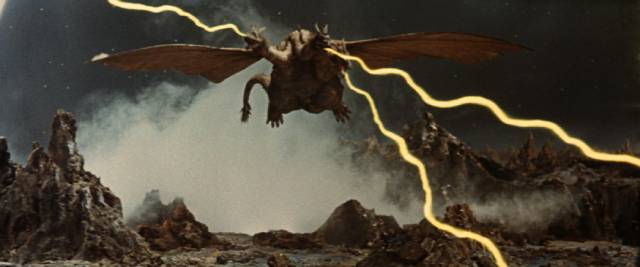
As far as I can remember, the first kaiju movie I ever saw wasn’t on late night television but actually in a theatre in the early 1970s. That was Yoshimitsu Banno’s Godzilla vs Hedorah (aka Godzilla vs The Smog Monster, 1971). Almost five decades later, I still have a soft spot for what has long been derided as one of the lesser Godzilla movies, with its campy tone and seemingly sincere ecological message. That experience fixed my impression that kaiju movies were by definition cheesy entertainment.
It was a couple of decades later that I finally got to see the original Gojira (1954), thanks to a friend’s rather fuzzy bootleg VHS tape. That, as the cliche goes, was a revelation. Yes, it was still a man in a rubber suit stomping his way through large miniature sets, but the tone was grimly serious and the conclusion both melancholy and tragic. So at the genre’s inception there was no sign of the cheesiness; instead, director Ishiro Honda played the metaphor of nuclear destruction quite straight. If the idea of a giant dinosaur with radioactive breath was inherently absurd, the film left no room for mockery.
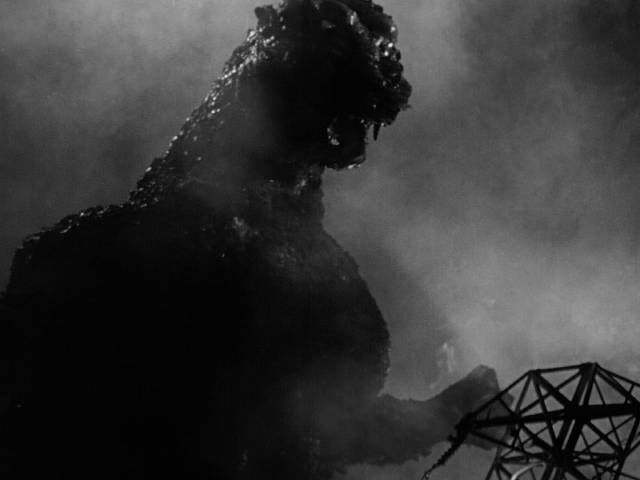
But that fact remained fairly unknown to the West until the original finally became more widely available much later; what English-speaking audiences had to make do with was Embassy Pictures’ dubbed, re-edited version, Godzilla: King of the Monsters (1956), which stripped away much of the drama while adding extensive new material directed by Terry O. Morse in which pipe-smoking reporter Raymond Burr lurks in corners, supposedly bearing witness to Japan’s fight against the big reptile.
The U.S. success of that version, largely seen by kids at matinees, may have prompted the Japanese producers at Toho to shift direction quite quickly, aiming the inevitable sequels at an audience of children. This lightened the tone and injected elements of comedy to alleviate the inherent grimness of all the death and destruction. (Interestingly, in the States, some movies at least in part inspired by Godzilla retained a more serious tone – Gordon Douglas’ Them! [1954], Jack Arnold’s Tarantula [1955].)
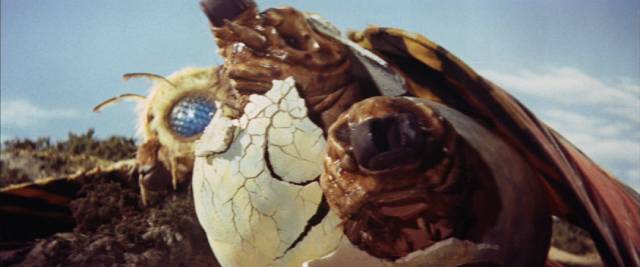
But perhaps that was an inevitable evolution; the inherent absurdity of these giant monsters couldn’t have sustained a serious tone for long, so in order to keep reaping profits it was no doubt wise to acknowledge and go along with the absurdity. And that meant aiming subsequent films at children who quickly developed an affection for Big G, who took on a more heroic role as he began to defend Earth from bigger, meaner monsters.
This process was speeded up in other studios’ imitations, particularly Godzilla’s biggest rival for kids’ pocket money, Daiei’s Gamera, who appeared more than a decade into the kaiju craze. By 1965, Toho’s monsters were firmly established as children’s fantasy figures, so Daiei could enter the fray with something as utterly absurd as a giant turtle who could fly with inexplicable rocket power, flames blasting out of the leg holes in his shell and making him spin like a giant Catherine wheel as he smashed into buildings and other monsters with brute force.
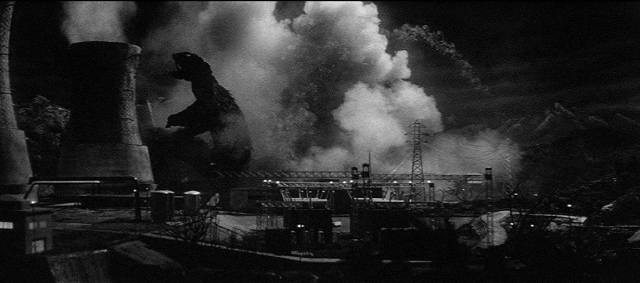
But even given that inherently silly image, the first movie, Noriaki Yuasa’s Gamera: The Giant Monster (1965), aimed for a serious tone – shot in black-and-white, it follows the Gojira model, with a nuclear explosion waking the sleeping monster from the Arctic ice, leading to scenes of mass urban destruction. The most notable difference is that instead of a bomb test, the explosion results from Cold War tensions, with the U.S. shooting down a Russian plane carrying a big bomb. The flying turtle rampages around the world, wreaking havoc before being temporarily defeated.
As with Gojira, a much re-edited U.S version renamed Gammera the Invincible (1966) added extensive scenes with English-speaking actors, directed by Sandy Howard and focusing on the American military joining the battle. (No explanation for the extra “m” in the name.)
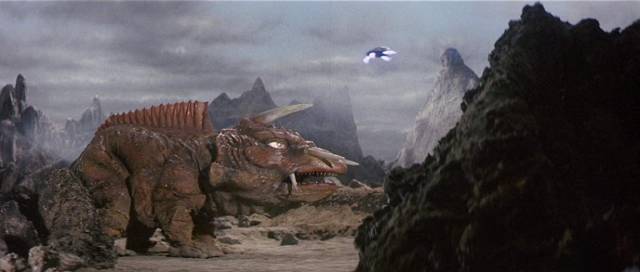
One of the most distinctive elements of Gamera is that, despite the generally serious tone, it incorporates supposed kid appeal by introducing a gratingly irritating child into the action. Toshio (Yoshiro Uchida) for no apparent reason quickly deduces that the giant turtle smashing its way around the globe, destroying cities and no doubt killing thousands, isn’t bad, just misunderstood. And he works hard to get the adults to stop attacking Gamera. In the ensuing movies, the flying turtle, like Godzilla, takes on the role of defender of Earth and “friend of all children”, making room for young characters of varying degrees of obnoxiousness.
This trend was picked up by Toho, which squarely targeted the kiddie market with Jun Fukuda’s Son of Godzilla in 1967, introducing the tediously “cute” Minilla, a miniature Godzilla still endowed with baby fat and getting up to antics supposedly appealing to a young audience. Much time is spent on Big G’s tough-love efforts to train his son in the arts of wrestling and boxing and blowing radioactive breath. By the time of Honda’s All Monsters Attack (1969), the kaiju literally become figments of a child’s imagination as a young boy being bullied at school dreams of Minilla on Monster Island and learns from Godzilla’s tutoring of his son how to face down the bullies and defend himself … though strangely, without comment or irony, at the end the boy’s new-found confidence makes him the bully.
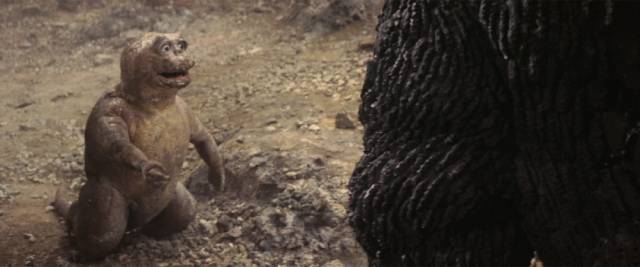
But even as the kaiju movies devolved into kids’ matinee fodder, they retained an appeal for older genre viewers. Having recently binged Criterion’s eight-disk Godzilla: The Showa-Era Films 1954-1975 Blu-ray set, which includes all fifteen features starring or co-starring Big G (plus the alternate English-language versions of Gojira and King Kong vs Godzilla [1962]), and Arrow’s eight-disk Gamera: The Complete Collection, which includes all twelve Gamera features plus several English-language variants, I’ve been reminded of the pleasures of traditional kaiju movies, pleasures which more recent CGI versions simply can’t match.
The supposedly more realistic effects in the newer versions actually work against those pleasures. The gradual shift to an appeal to children, while dictated to some degree by the audience itself, reflects something inherent in the very concept of kaiju: the miniature sets, the obvious rubber suits, and the almost gleeful immersion in large-scale destruction can be seen as a form of imaginative play, reducing the world to the scale of an elaborate children’s playroom and reminding adult viewers of the pleasures of make-believe. Kaiju are by their nature anti-realistic, figments of an immature imagination. This is something Guillermo del Toro understands, which is why Pacific Rim (2013) is the only really successful modern iteration of the genre.
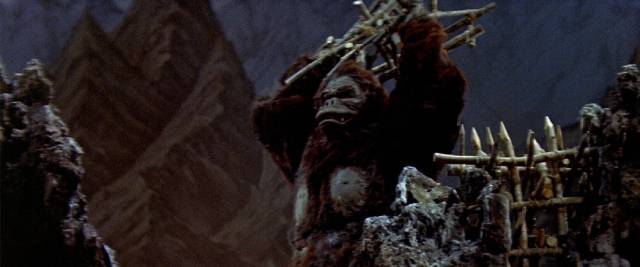
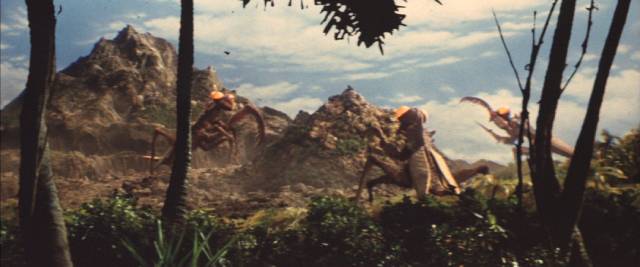
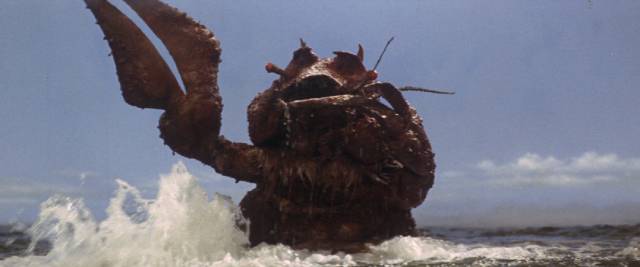
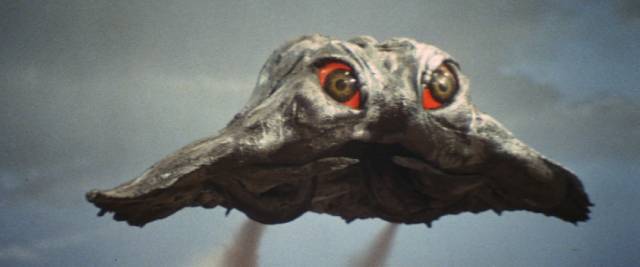
As for the two Blu-ray sets, I was surprised to find that my enjoyment of the Gamera movies far outweighed the pleasure of Criterion’s Godzilla collection. I admit that this is in part based on superficial impressions. That is, Arrow’s packaging is much more impressive. Criterion’s eight disks come in a large hardcover storybook case, with thirty-six pages containing a brief introduction by Godzilla authority Steve Ryfle and two pages devoted to each movie, with credits, colourful illustrations and a short essay. The disks are slotted into two thick cardboard panels at the back. Apart from the supplements from Criterion’s previous 2011 edition of Gojira being ported over on the first disk, the rest of the films get bare bones treatment, with two or three movies squeezed onto each disk, and a handful of other extras included on the eighth disk. With all the commentaries and featurettes previously available on various DVD releases, it’s a pity Criterion didn’t license anything to beef up their set.
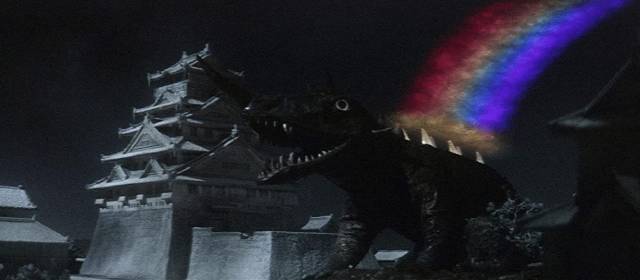
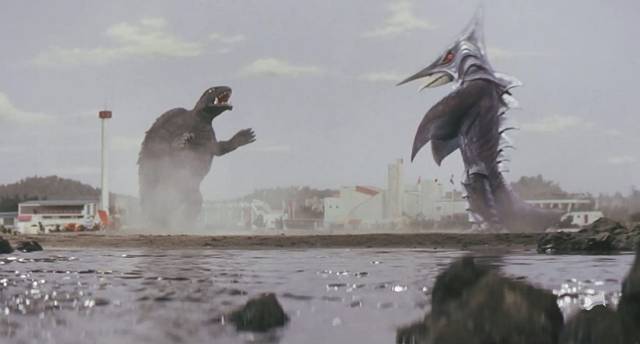
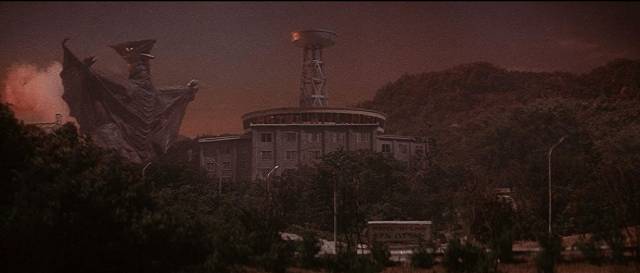
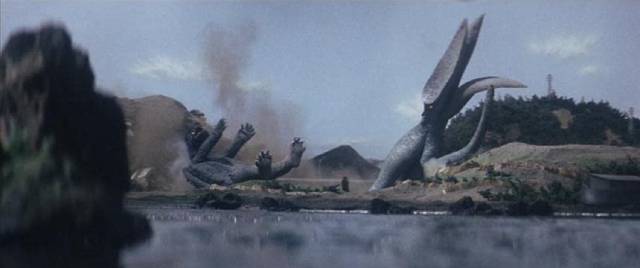
Arrow, on the other hand, have gone all-out for their set. Housed in a sturdy box, the disks are held in the pages of a board book with dynamic artwork. There are two other books included – an eighty-page paperback packed with essays, interviews and artwork, plus a 130-page hardcover full-colour reproduction of a four-issue comic book from 1995 timed to coincide with Gamera’s revival in the Heisei Trilogy. Each disk is packed with extras, including a commentary on each film and numerous featurettes with interviews and behind-the-scenes material; the Heisei Trilogy gets more than six hours of making-of documentaries spread across the three disks. All-in-all, if this was a contest, Arrow would win hands-down.
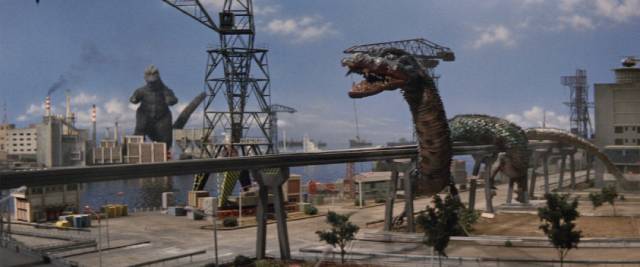
in Ishiro Honda’s Destroy All Monsters (1968)
But there are other reasons as well for giving the ribbon to Arrow. One Criterion can’t be faulted for, because of the conception of their set: its focus is specifically on Godzilla and the truth is that these films don’t all represent the best Toho had to offer. Absent are The Mysterians (1957), the first Mothra (1961, my personal favourite in the whole kaiju canon), Gorath (1962) – admittedly more of a disaster film though at one point, no doubt purely for box office reasons, a kaiju does show up – Atragon (1963), Dogora (1964), Frankenstein Conquers the World (1965) and War of the Gargantuas (1966), all directed by Ishiro Honda. Many of these are more interesting movies than the later, repetitive Godzilla features, which increasingly made use of stock footage from earlier films.
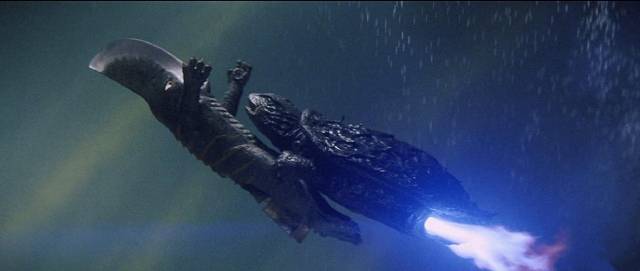
I had expected to find the Gamera movies to be shoddier than Toho’s bigger-budgeted efforts, but the effects in many of them are impressive within the limitations of the smaller studio. At times they’re reminiscent of Gerry and Sylvia Anderson’s various puppet productions of the mid-to-late-’60s. But what I really liked was the imaginative creature designs, which are often more interesting than Toho’s. While Baragon, Gamera’s foe in his second movie, is a fairly standard giant horned lizard, Gyaos in the third movie is an angry flying reptile with a head shaped like an anvil and a deadly laser beam which fires from his mouth; Viras is a giant space squid and Guiron is part fish, part lizard with a massive blade for a head; Jiger is another aquatic creature which lays eggs inside Gamera’s body, necessitating a couple of irritating boys to go inside in a mini-sub Fantastic Voyage-style to help the giant turtle out; and Zigra is a fantastical shark-headed beast. The last of the first round of Gamera movies, Gamera Super Monster (1980), like the Godzillas of the late ’60s, was an under-funded clip show, stringing together the big scenes of the previous movies with a very thin new storyline.
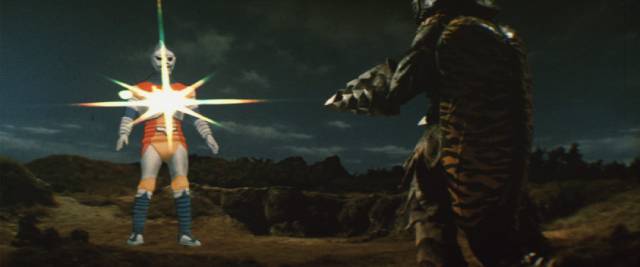
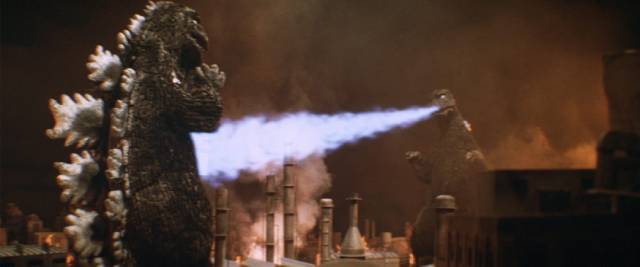
Which is not to say that the Godzilla movies lack imaginative design. While there was a tendency to lean on the giant dinosaur model (Anguiras, Rodan), there’s also the fairytale creature Mothra and her wonderful larvae; the long slinky Manda and the three-headed space dragon King Ghidorah; the giant crustacean Ebirah, the huge praying mantis Kamacurus and the impressive spider Kumonga; and the giant pile of living sludge Hedorah. Many of these are gathered together and contained by the United Nations on Monster Island, though aliens repeatedly attempt to control them to attack and subdue the population of Earth. As the series went on, Godzilla was occasionally lost in the crowd. In the later films, which began to resemble the popular fantasy TV series of the time, robots became a major element – Jet Jaguar, which inexplicably has the ability to grow to monster size and wrestle various kaiju, and the gleaming metal Mechagodzilla, built by aliens and initially disguised inside a Godzilla suit to make it seem that Big G has turned to the dark side.
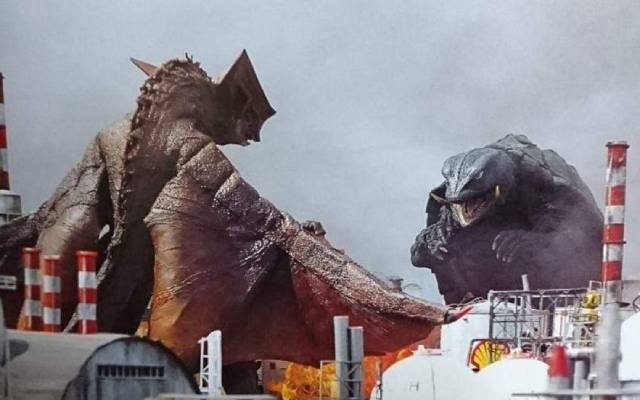
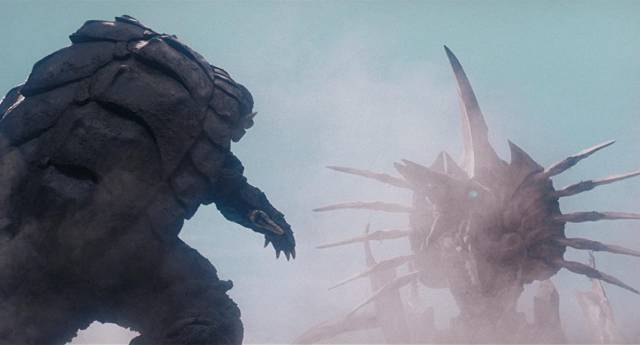
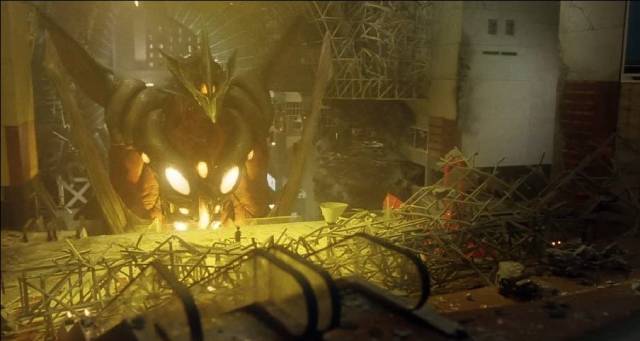
Criterion’s set stops with 1975’s Terror of Mechagodzilla, Ishiro Honda’s final contribution to the series, which manages to some small degree to restore an air of gravitas after the increasingly cartoonish movies of the previous eight years, but Toho went on to revive their big star several times over the following two decades with varying results before Roland Emmerich’s Godzilla (1998) discarded the entire history of the character and turned him into nothing but a big, personality-free lizard. The following year Toho reclaimed Big G with Takao Okawara’s passable Godzilla 2000 (1999). The same thing happened a decade-and-a-half later, when Toho once again reclaimed him with Hideako Anno and Shinji Higuchi’s fine Shin Gojira (2016) two years after Gareth Edwards’ bloated and tedious Godzilla (2014).
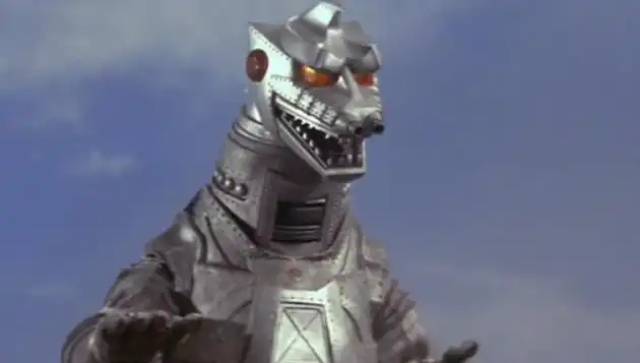
Gamera, Godzilla’s poor cousin, strangely fared much better, being revived in an epic trilogy directed by Shusuke Kaneko between 1995 and 1999. Big, dark, packed with action and impressive effects, Gamera: Guardian of the Universe (1995), Gamera 2: Attack of Legion (1996) and Gamera 3: Revenge of Iris (1999) invest the flying turtle with character and pit him against a series of worthy enemies, beginning with a revival of Gyaos in the first film, swarming insects from space in the second (a year before Starship Troopers), and in the third film, which begins with the reappearance of Gyaos, Gamera finds himself up against Iris, a monster which has fused with a girl consumed by anger because her family died as collateral damage years earlier when a fight between Gamera and another monster crushed her home. This narrative thread adds some genuine psychological depth, no mean feat when you remember that it’s a movie about a giant rocket-powered turtle.
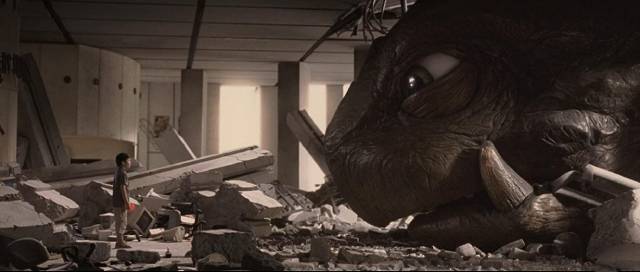
Another seven years passed before Gamera’s final appearance in Ryuta Tasaki’s Gamera the Brave (2006), something of a reversion to the early Gamera, friend of all children, and a kind of origin story in which a lonely boy is given a pet turtle which develops strange powers as it grows – like the ability to fly. A child-focused movie with themes of attachment and loss, it remains light even when a new monster threat shows up, more about a kid coming to terms with the world than about a giant turtle saving the world. In keeping with the new tone, Gamera was redesigned to be more cuddly – like the later Showa Godzilla which took on a distinctly feline look to be more appealing to his young audience.
*
Needless to say, the quality of the transfers in both sets varies with the age and condition of the source materials, but overall both Godzilla and Gamera are served well on Blu-ray. As collector’s items, both sets are appealing, though as previously mentioned Arrow’s Gamera collection is the more impressive of the two.
Comments